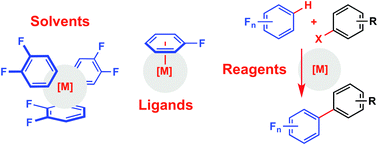Organometallic chemistry using partially fluorinated benzenes
Abstract
Fluorobenzenes, in particular fluorobenzene (FB) and 1,2-difluorobenzene (1,2-DiFB), are increasingly becoming recognised as versatile solvents for conducting organometallic chemistry and transition-metal-based catalysis. The presence of fluorine substituents reduces the ability to donate π-electron density from the arene and consequently fluorobenzenes generally bind weakly to metal centres, allowing them to be used as essentially non-coordinating solvents or as readily displaced ligands. In this context, examples of well-defined complexes of fluorobenzenes are discussed, including trends in binding strength with increasing fluorination and different substitution patterns. Compared to more highly fluorinated benzenes, FB and 1,2-DiFB typically demonstrate greater chemical inertness, however, C–H and C–F bond activation reactions can be induced using appropriately reactive transition metal complexes. Such reactions are surveyed, including catalytic examples, not only to provide perspective for the use of FB and 1,2-DiFB as innocent solvent media, but also to highlight opportunities for their exploitation in contemporary organic synthesis.



 Please wait while we load your content...
Please wait while we load your content...